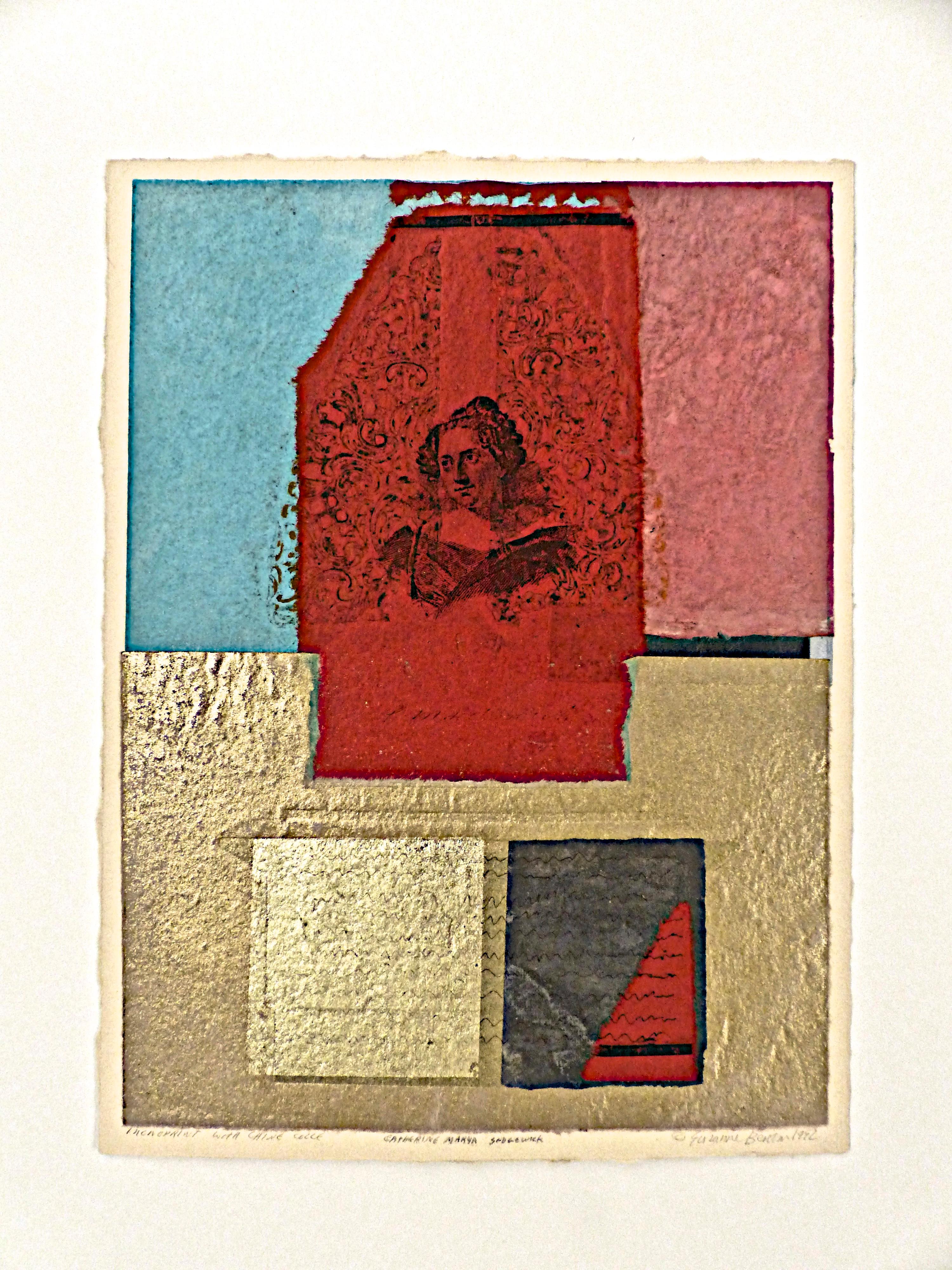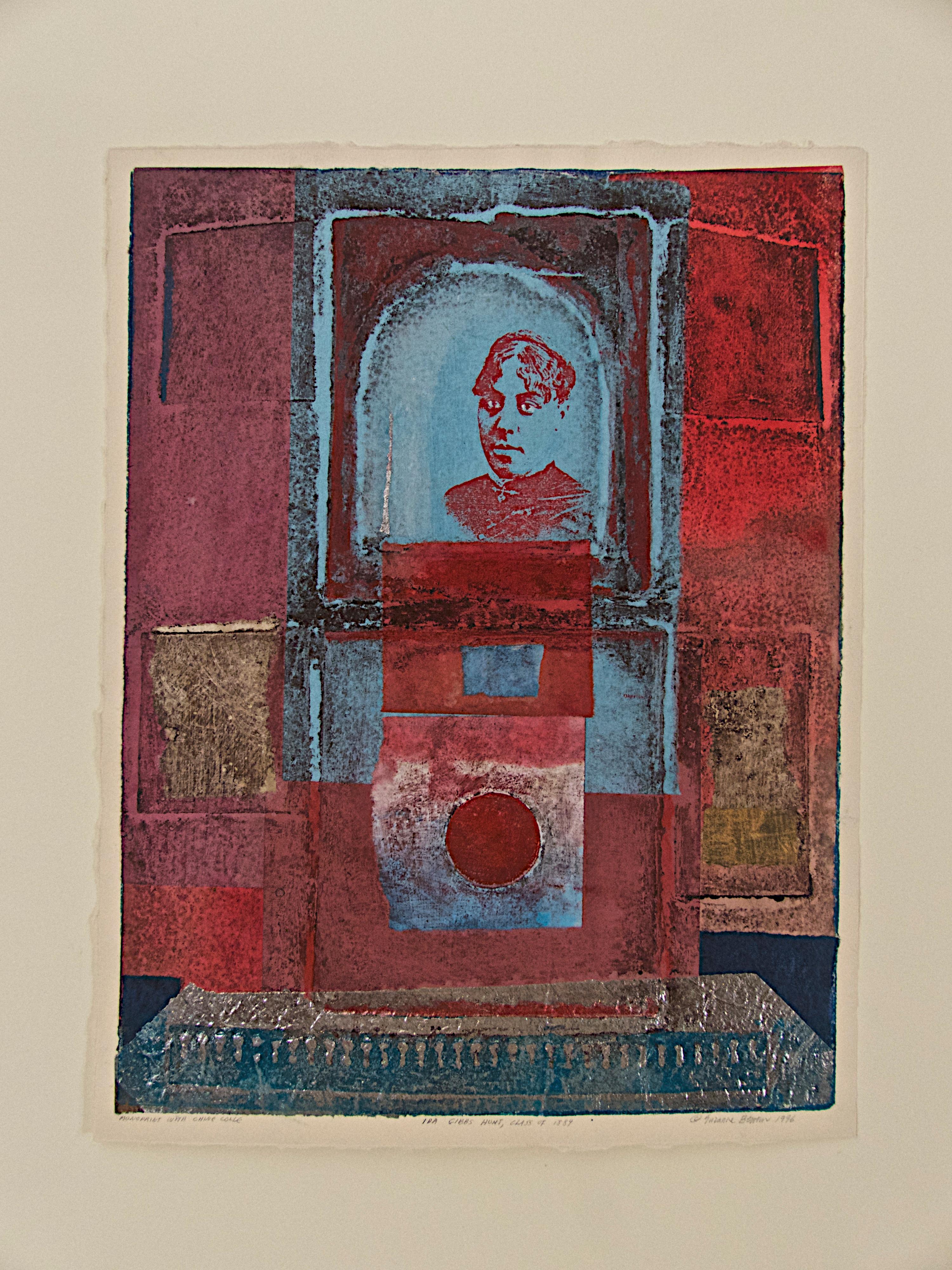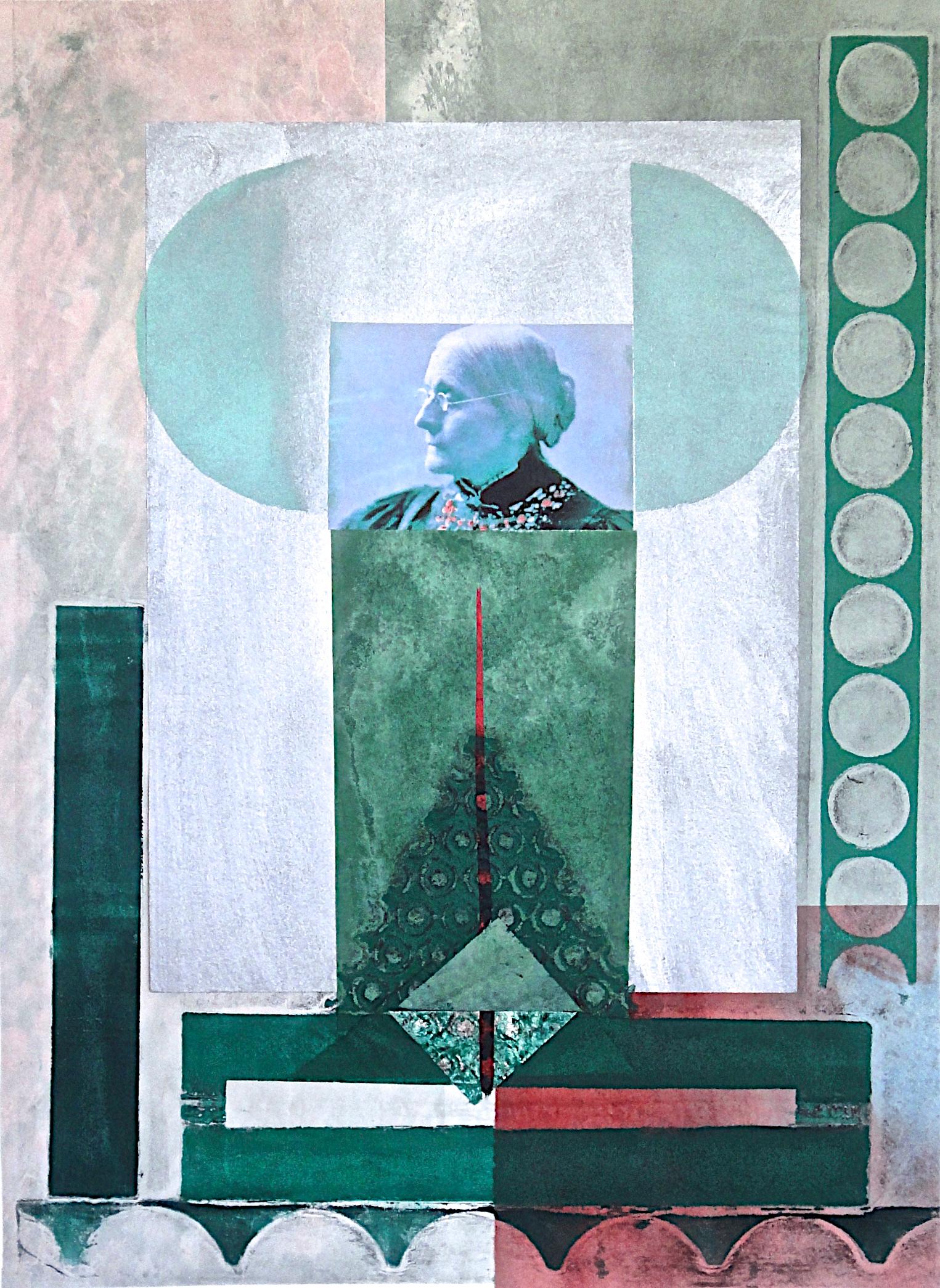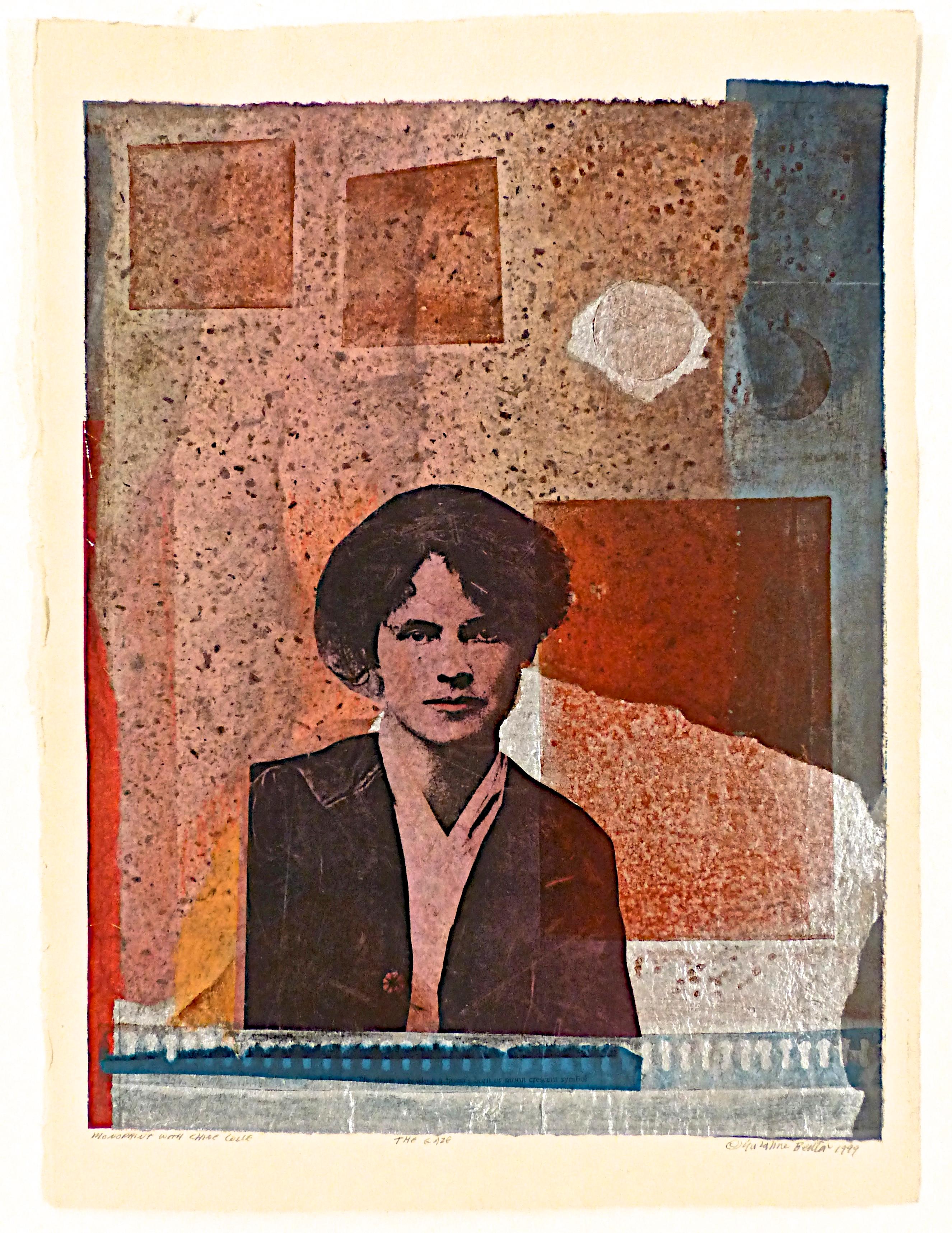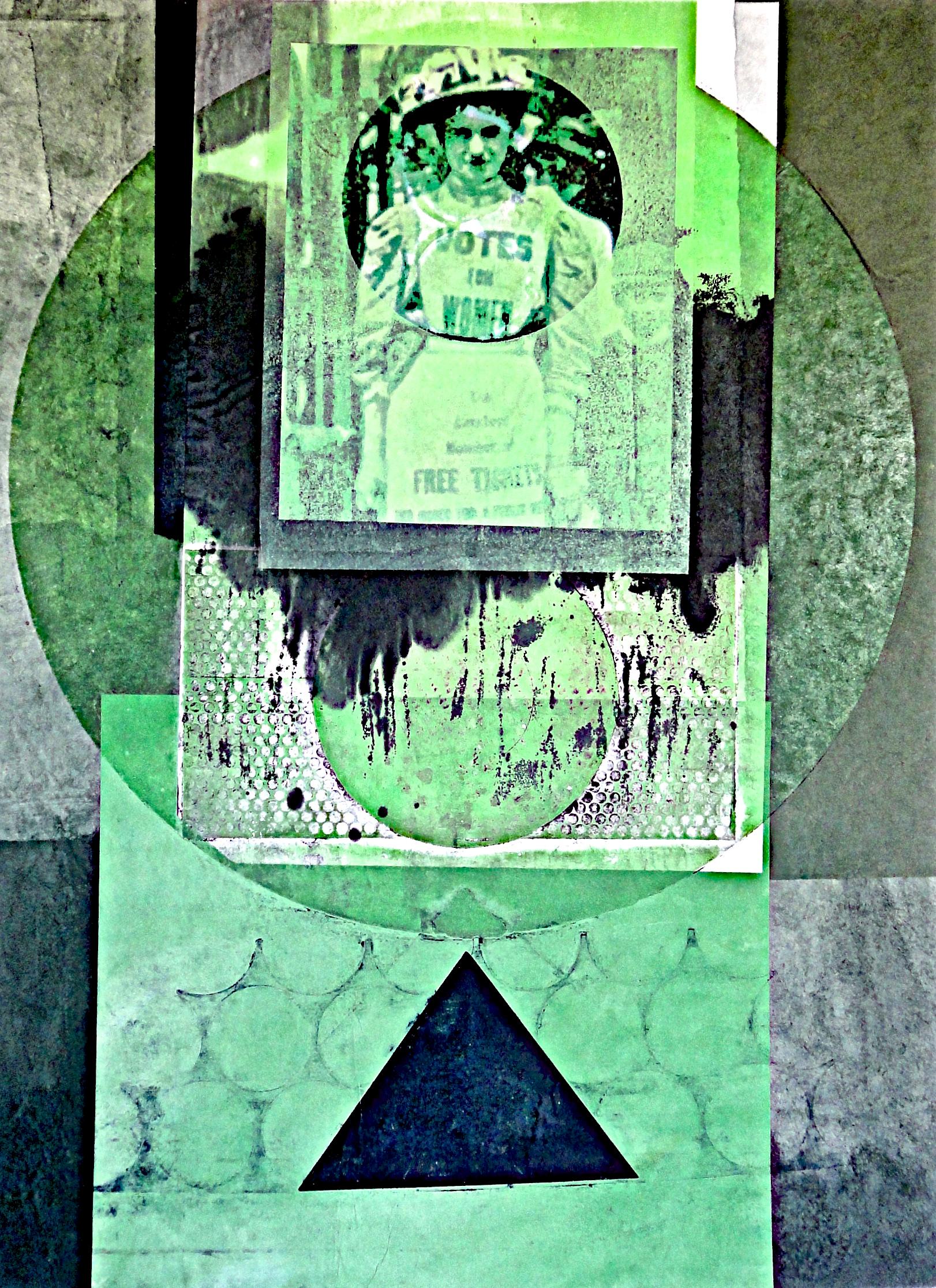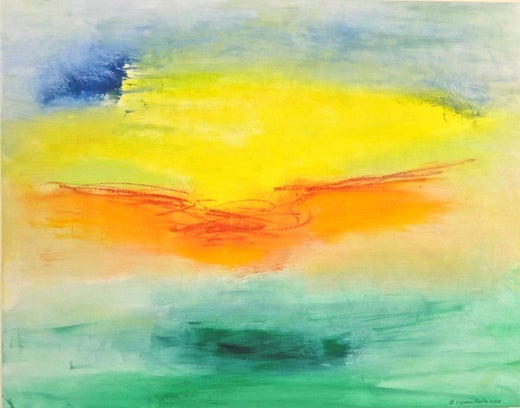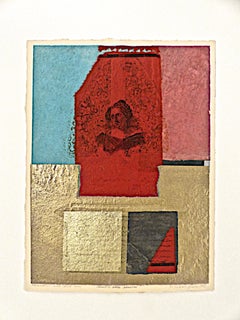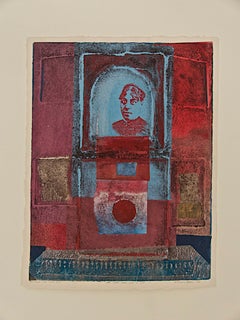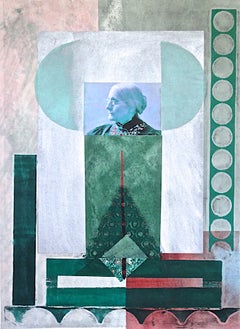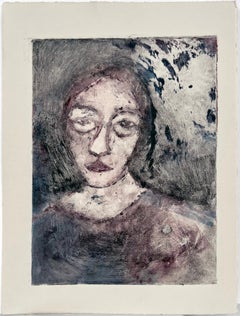Items Similar to Benton, Mabel Loomis Todd, monoprint with Chine collé, Pioneer Activist
Want more images or videos?
Request additional images or videos from the seller
1 of 2
Suzanne BentonBenton, Mabel Loomis Todd, monoprint with Chine collé, Pioneer Activist1992
1992
$1,800
£1,335.67
€1,555.87
CA$2,505.61
A$2,790.23
CHF 1,452.16
MX$34,403.15
NOK 18,494.35
SEK 17,382.90
DKK 11,608.74
Shipping
Retrieving quote...The 1stDibs Promise:
Authenticity Guarantee,
Money-Back Guarantee,
24-Hour Cancellation
About the Item
Pioneer Activists is an ongoing series of artworks by Suzanne Benton. Consisting largely of monoprints with Chine collé where the artist references suffragists, feminists, writers and educators from the 19th century and beyond. These works embody the artist’s stellar theme of bringing past to present.
Mabel Loomis Todd, monoprint with Chine collé, 10 3/4"x 8 3/4," 1992
(1856 – 1932)
Raised in Cambridge, Massachusetts and Washington, D. C., Mabel Loomis Todd studied music at the New England Conservatory.
In 1879 she married astronomer David Peck Todd and moved to Amherst, Massachusetts where her husband began teaching at Amherst Collége. While there, Todd became acquainted with the Emily Dickinson and read some of her poems, although the two never met face-to-face. After Dickinson’s death, Lavinia Dickenson, the poet’s sister, approached Todd for help in publishing the poems. With the assistance of Dickinson’s literary mentor, Thomas Wentworth Higginson, Todd edited the first volume of Dickinson’s verse, released in 1890.
The Women’s Rights Historical Park exhibited the growing series in 1995 during the 75th anniversary of women’s suffrage. The Oberlin College Library offered their photo archive of early women attendees and graduates that also including African American women. The artist exhibited 19th Century Women at Oberlin College, a collaboration between Oberlin College and FAVA Art Center in 1996. Oberlin subsequently purchased the more than 20 works they keep on rotating display throughout college buildings. In 2018, the Oberlin College library, changed its name to the Mary Church Terrell Library, and Suzanne received a commission to create a large monoprint using photos of this pioneer African American Civil Rights activist. An exhibit of the library’s holdings of Suzanne’s monoprints were exhibited at the official re- naming ceremony.
Most of the artworks in this series have been acquired. The Women’s Rights National Historical Park, Seneca Falls, NY; the Radcliffe/Harvard Schlesinger Library, Cambridge, MA; Oberlin College, Oberlin, OH; Central Connecticut College, New Britain, CT; and the Ridgebury Congregational Church, Ridgefield, CT keep the works on permanent display. Others from the series are owned by the Allyn Museum, Oberlin, OH; St Petersburg Museum of Fine Arts, St Petersburg, FL; Lyman Allen Museum, New London, CT; and the Mattatuck Museum, Waterbury, CT.
Suzanne Benton is a native New Yorker who has shared her many-faceted art for over 60 years and in 32 countries. Exhibiting widely (150+ solo shows and representation in museums, and private collections worldwide), she’s a highly recognized metal mask maker and mask performance artist, printmaker, painter, lecturer, and workshop leader. A trans-culturalist and feminist pioneer based in the States, her venues have stretched from New York City to villages in remote parts of Africa, India, and Nepal, and to philosophy and education portals from Calcutta to Cambridge. A former Fulbright Scholar (India), she’s received many grants and artist residencies, including numerous hostings by the cultural arm of US Embassies. Her unique artwork has carried her worldwide since 1976, sharing her work in Bali, Bangladesh, Bosnia, Bulgaria, Canada, Hong Kong, Denmark, Egypt, England, Germany, Greece, India, Ireland, Israel, Italy, Japan, Kazakhstan, Kenya, South Korea, Morocco, Nepal, Netherlands, Nigeria, Pakistan, Poland, Spain, Switzerland, Tanzania, Tunisia, Turkey, Yugoslavia. Author of The Art of Welded Sculpture and various articles, Suzanne is listed in Who’s Who in America, Who’s Who in American Art, and Feminists Who Changed America 1963-1975, Edited by Barbara Love, 2006.
- Creator:Suzanne Benton (American)
- Creation Year:1992
- Dimensions:Height: 10 in (25.4 cm)Width: 8.75 in (22.23 cm)
- More Editions & Sizes:Ed 3, 60 x 40 archival pigment print/ inches Price: $5,400
- Medium:
- Movement & Style:
- Period:
- Condition:For Benton's Pioneer Activists and Oberlin College series, we are offering a limited edition large scale archival pigment print of the women who created the foundation for Equal Rights in our country. Please contact the gallery to commission.
- Gallery Location:Darien, CT
- Reference Number:1stDibs: LU17227679562
Suzanne Benton
Suzanne Benton is a celebrated pioneer feminist activist artist who has worked in 32 countries worldwide as a metal mask maker, mask performance artist, sculptor, printmaker, painter, lecturer and workshop leader. Her seven decades-long art life continues to evolve. She is currently writing the memoir, The Spirit of Hope. Born, raised and educated in NYC (Queens College, Fine Arts alum), Suzanne Benton is a printmaker, painter, metal sculptor, mask maker/performance artist, lecturer, and workshop leader. Believing the purpose of art is to explore humanity, and that art comes alive when it relates to people’s lives, Benton has been drawn to multicultural themes steeped in myth, ritual, and archetype. This work oftentimes engages participation. Bridging cultures, venues featuring Benton's artworks and performances, have stretched from New York City to villages in remote parts of Africa, India, and Nepal, as well as philosophy and education portals from Calcutta to Cambridge. A former Fulbright Scholar (India), recipient of many grants, artist residencies, and hostings by the cultural arm US Embassies, her worldwide travels began with a 1976 to 1977 yearlong journey as a feminist pioneer to 14 countries where she welded metal masks, developed and performed what became Journey Tales, and led mask and story workshops. That pattern, spurred on by wanderlust and curiosity has brought her to Bali, Bangladesh, Bosnia, Bulgaria, Canada, China, Denmark, Egypt, England, Germany, Greece, Holland, India, Ireland, Israel, Japan, Kenya, Korea, Morocco, Nepal, Nigeria, Pakistan, Spain, Switzerland, Tanzania, Tunisia, Turkey, and Yugoslavia. Beyond exhibiting widely (150+ solo shows and representation in museums, and private collections worldwide), I’m the author of The Art of Welded Sculpture and numerous articles. the artist has been listed in, among others Who’s Who in America, Who’s Who in American Art, and Feminists Who Changed America 1963-1975, edited by Barbara Love, 2006. As a journeying artist, Benton has sought to filter the treasures of newness, of sharing, spectacle, friendship and insight into her artwork. In this ninth decade of life, and as a working artist for nearly 70 years, the artist will give occasional mask performances (March 9 at the Leepa-Rattner Museum, Tarpon Springs, FL) , in addition to her printmaking, is painting in a Late Style that arrived as a surprise during the Covid pandemic. The resultant aloneness from sheltering in place brought an uncanny level of solitude that only painting could voice. Reaching for the purist of colors, she then entered a celebratory world of Neo-Transcendental paintings called All About Color while continuing to write her memoir, The Spirit of Hope.
About the Seller
5.0
Vetted Professional Seller
Every seller passes strict standards for authenticity and reliability
Established in 2014
1stDibs seller since 2015
143 sales on 1stDibs
Typical response time: 6 hours
- ShippingRetrieving quote...Shipping from: New York, NY
- Return Policy
Authenticity Guarantee
In the unlikely event there’s an issue with an item’s authenticity, contact us within 1 year for a full refund. DetailsMoney-Back Guarantee
If your item is not as described, is damaged in transit, or does not arrive, contact us within 7 days for a full refund. Details24-Hour Cancellation
You have a 24-hour grace period in which to reconsider your purchase, with no questions asked.Vetted Professional Sellers
Our world-class sellers must adhere to strict standards for service and quality, maintaining the integrity of our listings.Price-Match Guarantee
If you find that a seller listed the same item for a lower price elsewhere, we’ll match it.Trusted Global Delivery
Our best-in-class carrier network provides specialized shipping options worldwide, including custom delivery.More From This Seller
View AllBenton, Catherine Marya Sedgewick, monoprint with Chine collé, PioneerActivist
By Suzanne Benton
Located in Darien, CT
Pioneer Activists is an ongoing series of artworks by Suzanne Benton. Consisting largely of monoprints with Chine collé where the artist references suffragists, feminists, writers an...
Category
2010s Feminist Portrait Prints
Materials
Gold Leaf
Benton, Carrie Chapman Catt, monoprint with Chine collé, Pioneer Activist
By Suzanne Benton
Located in Darien, CT
Pioneer Activists is an ongoing series of artworks by Suzanne Benton. Consisting largely of monoprints with Chine collé where the artist references suffragists, feminists, writers and educators from the 19th century and beyond. These works embody the artist’s stellar theme of bringing past to present.
Carrie Chapman Catt, monoprint with Chine collé, 18 ¾ "x 12 15/16", 1992
(1859 – 1947)
The women’s right to vote in the United States is owed largely to the efforts of Carrie Chapman Catt.
Born in Wisconsin and educated at Iowa State, Catt left work as a high school principle and later as a newspaper editor to join the fight for women’s suffrage.
Skilled as a lecturer, Catt rose rapidly to national leadership, succeeding Susan B. Anthony as president of the National/American Women’s Suffrage Association in 1900.
Catt’s pressure on President Woodrow Wilson and her tireless work to secure state ratification, culminated in the Nineteenth Amendment’s adoption in 1920.
Following suffrage work, Catt devoted herself to peace and disarmament issues, serving as chair of the Committee on the Cause and Cure of War.
The Women’s Rights Historical Park exhibited the growing series in 1995 during the 75th anniversary of women’s suffrage. The Oberlin College...
Category
1990s Feminist Portrait Prints
Materials
Gold Leaf
Benton, Ida Gibbs Hunt, Class of 1884, monoprint with Chine collé, Oberlin
By Suzanne Benton
Located in Darien, CT
Pioneer Activists is an ongoing series of artworks by Suzanne Benton. Consisting largely of monoprints with Chine collé where the artist references suffragists, feminists, writers an...
Category
1990s Feminist Portrait Prints
Materials
Gold Leaf
Benton, Susan B. Anthony the Elder, monoprint with Chine collé, PioneerActivist
By Suzanne Benton
Located in Darien, CT
Pioneer Activists is an ongoing series of artworks by Suzanne Benton. Consisting largely of monoprints with Chine collé where the artist references suffragists, feminists, writers and educators from the 19th century and beyond. These works embody the artist’s stellar theme of bringing past to present.
Susan B. Anthony the Elder, monoprint with Chine collé, 18 ½ x 13 ¼ inches, 2020
From Wikipedia
Susan B. Anthony (born Susan Anthony; February 15, 1820 – March 13, 1906) was an American social reformer and women's rights activist who played a pivotal role in the women's suffrage movement. Born into a Quaker family committed to social equality, she collected anti-slavery petitions at the age of 17. In 1856, she became the New York state agent for the American Anti-Slavery Society.
In 1851, she met Elizabeth Cady Stanton, who became her lifelong friend and co-worker in social reform activities, primarily in the field of women's rights. In 1852, they founded the New York Women's State Temperance Society after Anthony was prevented from speaking at a temperance conference because she was female.
In 1863, they founded the Women's Loyal National League, which conducted the largest petition drive in United States history...
Category
2010s Feminist Portrait Prints
Materials
Laid Paper, Monoprint
Benton, The Gaze (Dorothy Canfield Fisher) monoprint with Chine collé, Feminist
By Suzanne Benton
Located in Darien, CT
Pioneer Activists is an ongoing series of artworks by Suzanne Benton. Consisting largely of monoprints with Chine collé where the artist references suffragists, feminists, writers and educators from the 19th century and beyond. These works embody the artist’s stellar theme of bringing past to present.
THE GAZE
Monoprint with Chine collé, 13 ¼ x 10 inches, 1999
Dorothy Canfield Fisher
1879 –1958)
Dorothy Canfield Fisherwas an educational reformer, social activist, and best-selling American author in the early 20th century. She strongly supported women's rights, racial equality, and lifelong education. Eleanor Roosevelt named her one of the ten most influential women in the United States.
The Women’s Rights Historical Park exhibited Benton's growing series in 1995 during the 75th anniversary of women’s suffrage. The Oberlin College...
Category
1990s Feminist Portrait Prints
Materials
Silver
Benton, Votes for Women, monoprint with Chine collé, PioneerActivist
By Suzanne Benton
Located in Darien, CT
Pioneer Activists is an ongoing series of artworks by Suzanne Benton. Consisting largely of monoprints with Chine collé where the artist references suffragists, feminists, writers an...
Category
2010s Feminist Portrait Prints
Materials
Laid Paper, Monoprint
You May Also Like
Vintage Etching Abstracted Portrait of Amazing Grace
By Claudette McElroy
Located in Soquel, CA
Bold, slightly abstracted etching of an elderly woman titled "Amazing Grace" by Claudette McElroy (American, b. 1943). Signed on verso "Claudette McElroy" in the lower right corner, ...
Category
Late 20th Century Contemporary Portrait Prints
Materials
Paper, Ink, Etching
Elizabeth Etched, Signed Modern Etching by Grace Hartigan
By Grace Hartigan
Located in Long Island City, NY
Elizabeth Etched
Grace Hartigan, American (1922–2008)
Date: 1984
Color Etching on wove paper, signed and numbered in pencil
Edition of 50
Size: 40.5 x 30.5 in. (102.87 x 77.47 cm)
Pu...
Category
1980s Modern Portrait Prints
Materials
Etching
Abstract portrait of a Woman Finely Detailed Collotype on paper
Located in Soquel, CA
Abstract portrait of a Woman Finely Detailed Collotype on paper
Finely detailed abstract collotype of a woman by Heather Speck a San Francisco. Californi...
Category
1990s Abstract Expressionist Abstract Prints
Materials
Paper, Ink, Etching, Oil, Gouache
$680 Sale Price
20% Off
Abstracted Elder Portrait - Etching
By Claudette McElroy
Located in Soquel, CA
Bold, slightly abstracted etching of an elderly woman by Claudette McElroy (American, b. 1943). Signed "Claudette McElroy" in the lower right corner. Presented in a new cream mat. No...
Category
Late 20th Century Contemporary Portrait Prints
Materials
Paper, Ink, Etching
$220 Sale Price
20% Off
The Face - Original Etching and Aquatint- Mid-20th Century
Located in Roma, IT
The Face is an original print in etching and aquatint on paper realized by an anonymous artist of the mid-20th Century.
In very good conditions.
The artwork created through confide...
Category
Mid-20th Century Modern Figurative Prints
Materials
Etching, Aquatint
Ruth Leaf, Dowager, Embossed Screenprint, Etching, Artist Proof Signed
By Ruth Leaf
Located in San Francisco, CA
ABOUT
Ruth Leaf, Dowager, signed, titled and artist proof (AP) in pencil, embossed color etching and aquatint on wove paper.
CREATOR RUTH LEAF (1923-2015).
DATE OF MANUFACT...
Category
Mid-20th Century American Contemporary Art
Materials
Paper
